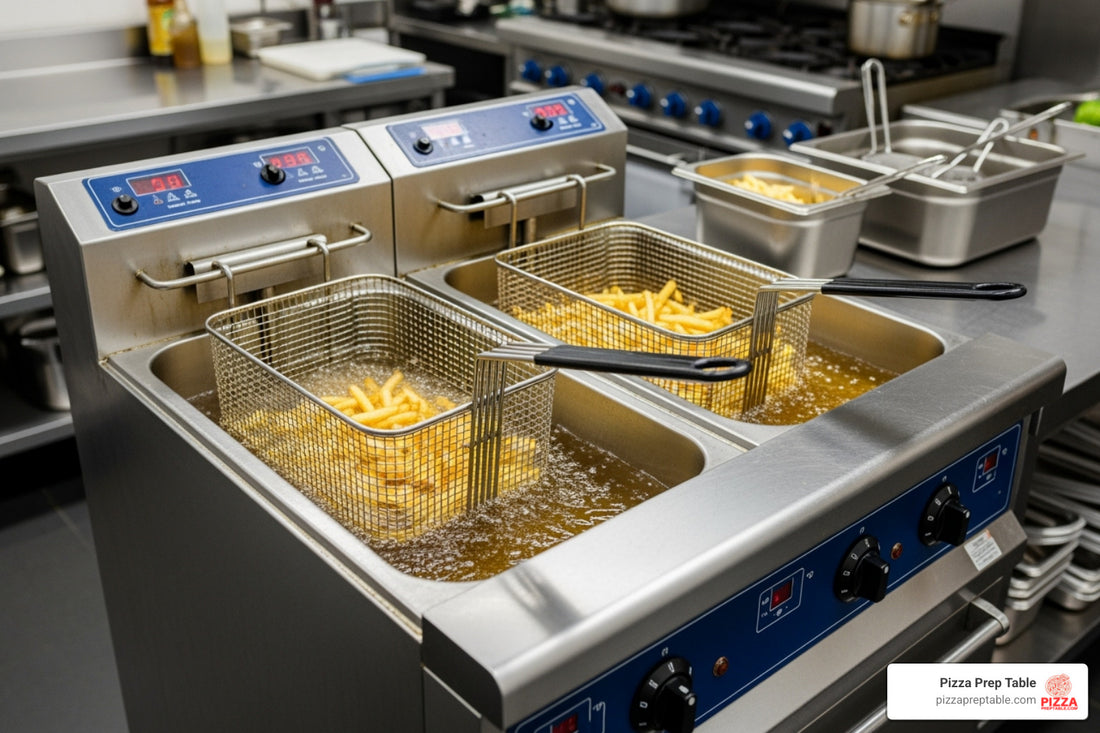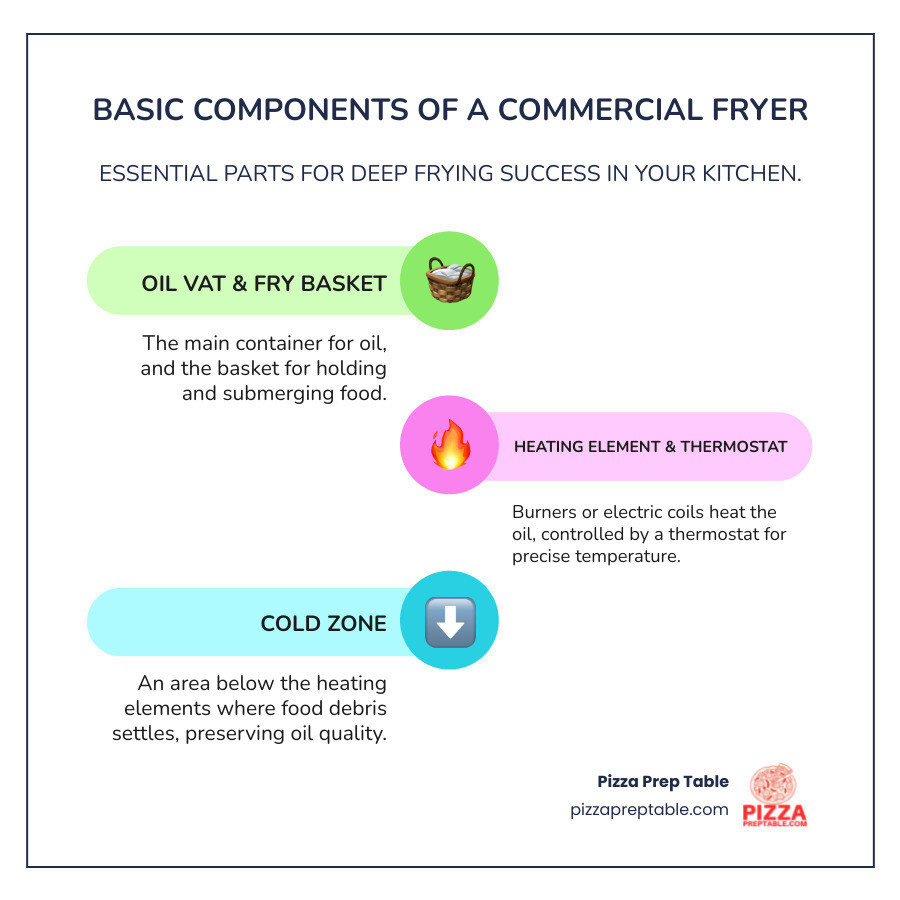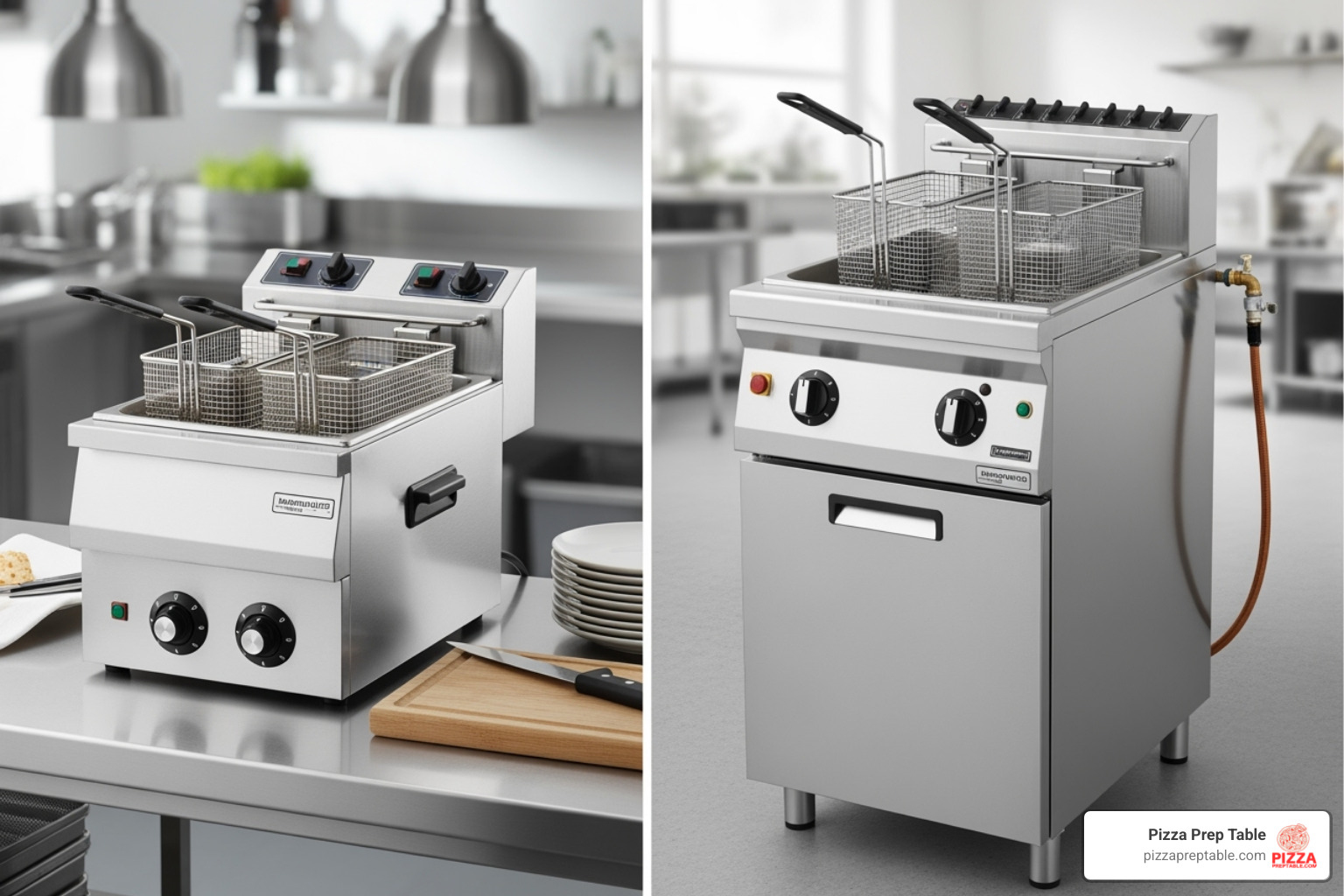
The Definitive Guide to Comparing Commercial Fryers
Share
Why Commercial Fryers Are Essential for Your Business
Commercial fryers are powerful kitchen appliances designed to heat large volumes of cooking oil for deep frying popular foods like french fries, chicken wings, and mozzarella sticks. Built for the demands of a busy restaurant, they are essential for any high-volume kitchen. Key benefits include:
- High Volume: Cook many servings quickly to meet customer demand.
- Efficiency: Designed for continuous, heavy-duty use during peak hours.
- Profitability: Boost sales of popular and high-margin fried menu items.
- Fast Recovery: Quickly regain optimal cooking temperature after adding cold or frozen food, ensuring consistent, high-quality results.
My name is Sean Kearney. With a background in sales and a deep appreciation for the food service industry, I understand how essential quality commercial fryers are for a restaurant's efficiency and profitability. This guide will help you choose the best fryer for your needs.

Understanding the Main Types of Commercial Fryers
Choosing the right commercial fryer means matching the equipment to your menu. Different designs are built for specific foods, and the right pairing leads to better quality, consistency, and easier cleanup. Let's explore the main types.
Open-Vat, Tube-Type, and Flat-Bottom Fryers
These three are the workhorses of most commercial kitchens:
- Open-Vat Fryers: With an open tank and external heating elements, these are perfect for low-sediment foods like french fries and onion rings. The smooth, V-shaped bottom makes cleaning easy, as sediment collects in a "cold zone" below the heat, preventing it from burning and spoiling the oil.
- Tube-Type Fryers: Ideal for heavily breaded items like fried chicken or mozzarella sticks, these fryers have heating tubes running through the oil. This design creates a large cold zone underneath, which is excellent for catching sediment from breading and extending oil life. They are a versatile and economical choice.
- Flat-Bottom Fryers: These are specialized for delicate, wet-battered foods like doughnuts, funnel cakes, or tempura. They lack a cold zone, providing even heat across the bottom for items that float. This design requires more frequent oil changes but is perfect for foods that don't shed much debris.
Seeing the inside of an open-vat, tube-type, and flat-bottom fryer side-by-side really helps show the difference in their design! Understanding the best commercial fryer for choosing the right menu items can seriously boost your food quality and make your kitchen run smoother.
Pressure Fryers and Ventless Fryers
Beyond the basics, some fryers solve unique challenges:
- Pressure Fryers: The secret to juicy, flavorful fried chicken, these units cook under pressure. This speeds up cooking times, seals out excess oil, and allows for frying at lower temperatures. They are ideal for high-volume, specific items but are not suited for freezer-to-fryer foods like fries.
- Ventless Fryers: These are a lifesaver for locations without a traditional hood system. Featuring a built-in ventilation and filtration system, they trap grease and odors at the source. This makes them perfect for kiosks, historic buildings, or high-rises. While they offer placement flexibility, they have a higher upfront cost and require filter maintenance.
Key Comparison Points: Power Source and Footprint
Your kitchen's infrastructure and available space are critical factors. The power source and physical size of the fryer impact installation, costs, and workflow.
Gas vs. Electric: Performance and Efficiency
The choice between gas and electric often depends on utility availability and cost in your area.
- Gas Fryers: Favored for fast heat-up times and high temperatures, many chefs prefer the powerful, responsive heat of a gas flame. Commercial Gas Deep Fryers are robust and reliable, though they require a dedicated gas line and ventilation. For mobile setups or locations without natural gas, Propane Power Commercial Deep Fryers are an excellent alternative.
- Electric Fryers: While initial heat-up can be slower, electric models often have faster recovery times between batches. Their submerged heating elements provide efficient heat transfer and superior temperature retention for consistent results. Commercial Electric Deep Fryers are generally more energy-efficient and can be easier to install.
Here's a quick comparison:
| Feature | Gas Fryers | Electric Fryers |
|---|---|---|
| Heat-up Time | Generally faster | Can be slower initially |
| Recovery Time | Good | Often faster and more consistent |
| Installation | Requires gas line, ventilation (Type I Hood) | Requires appropriate electrical outlet (often hardwired for floor models) |
| Operating Cost | Varies by local gas prices; can be lower | Varies by local electricity prices; can be higher |
| Efficiency | Efficient, but some heat loss | High efficiency due to submerged elements |
Countertop vs. Floor Model Commercial Fryers
Your available space and production volume will determine whether a countertop or floor model is best.
- Countertop Fryers: These compact units are ideal for kitchens with limited space or low- to medium-volume needs. Holding 10 to 30 pounds of oil, they are a cost-effective way to add fried items to your menu. See our Top Countertop Deep Fryers for Restaurants and Food Trucks for great options.
- Floor Fryers: For high-volume restaurants, a floor model is essential. These heavy-duty workhorses hold 40 to 100+ pounds of oil and are built for continuous use in a busy fry station, ensuring maximum throughput and profitability during peak hours.

Sizing, Features, and Cost: Finding the Perfect Fit
Beyond the basic type, you must consider output capacity, modern technology, and the total cost of ownership to make a smart investment.
How to Determine the Right Size and Number of Fryers
Analyze your menu and projected volume. To avoid flavor transfer between items like fish and fries, consider using multiple smaller commercial fryers instead of one large one. This is also crucial for managing allergens. To estimate production, a common rule of thumb is that a fryer can produce 1.5 to 2.0 times its oil capacity (in pounds) in food per hour. A 40 lb fryer, for example, can produce roughly 60-80 lbs of food per hour. Size your fryer based on your busiest shifts, with a little extra capacity for growth.
For businesses at high altitudes, remember to lower frying temperatures by about 3°F for every 1,000 feet of elevation to prevent burning.
Key Features and Technology in Modern Fryers
Modern commercial fryers include technology that boosts efficiency and consistency:
- Programmable Controls: Save cooking times and temperatures for specific menu items to ensure consistent results and simplify staff training.
- Automatic Basket Lifts: Prevent overcooking by automatically lifting food from the oil when the cycle is complete, freeing up staff for other tasks.
- Built-in Filtration Systems: A crucial feature that extends oil life, saving significant costs and ensuring better-tasting food. These systems make daily filtering fast and safe.
- Oil Quality Sensors: Advanced models can monitor the condition of your oil and alert you when it's time to filter or change it.
- ENERGY STAR Certification: Look for this certification to ensure high energy efficiency, which lowers your utility bills and reduces your environmental impact.
- High-Efficiency Burners: On gas models, these burners maximize heat transfer to the oil, reducing gas consumption and operating costs.
Understanding the Cost of Commercial Fryers
Look beyond the initial purchase price and consider the lifetime cost of ownership. Prices can range from a few hundred dollars for a countertop unit to tens of thousands for a high-volume floor model. A more expensive fryer with advanced features can save you money over time.
Key factors in lifetime cost include:
- Energy Savings: ENERGY STAR models and high-efficiency burners reduce utility bills.
- Oil Savings: Built-in filtration can double the life of your cooking oil, a major ongoing expense.
- Labor Reduction: Automated features like basket lifts and programmable controls save staff time.
- Durability: A well-built, properly maintained fryer can last 7-10 years, delaying replacement costs.
We know that new equipment is a significant investment. That's why we offer various financing options to help you get the best tools for your business without straining your cash flow. It's an investment that pays for itself in efficiency and quality.
Operation, Maintenance, and Essential Accessories
Proper use and regular maintenance are critical for food quality, safety, and extending the life of your fryer. A well-cared-for, heavy-duty commercial fryer can serve your kitchen for 7-10 years, making it a great long-term investment.
Best Practices for Using Your Fryer
Follow these steps for effective and safe operation:
- Preheat: Always allow the oil to reach its target temperature (typically 325°F-350°F) before adding food to prevent sogginess.
- Load Baskets Properly: Do not overfill baskets. Overloading drops the oil temperature, leading to greasy food and longer cook times.
- Drain Excess Oil: After cooking, let the basket hang over the fryer or use a dump station to drain excess oil before serving.
- Safety First: Always use Personal Protective Equipment (PPE) like heat-resistant gloves. Ensure high-limit temperature controls are working to prevent overheating. Your kitchen should have a proper fire suppression system over the fry station, and any oil leaks should be addressed immediately.
Cleaning, Maintenance, and Oil Management
Good maintenance keeps food tasting great. A key task is daily sediment removal to prevent burnt particles from ruining the oil's flavor. Periodically, perform a full "boil-out" by draining the old oil, cleaning the vat with a specialized solution, and rinsing thoroughly before adding fresh oil. Always consult your fryer's manual for specific cleaning instructions.
Regularly filtering your oil is the best way to maintain flavor and can double its lifespan. Filter daily, ideally while the oil is still warm. To further extend oil life, cover fryer vats when not in use to protect from debris and oxidation. When it's time to change the oil, use a rendering service for proper disposal; never pour used oil down the drain.
Must-Have Fryer Accessories
Equip your fry station with these essential accessories for smooth operation:
- Fry Baskets: Have several spares on hand for busy shifts.
- Skimmers/Strainers: For removing floating debris during service.
- Cleaning Brushes: Specialized brushes to scrub the fryer vat.
- Fryer Covers: Protect oil from contaminants when not in use.
- Oil Caddies: For safe transport and disposal of used oil.
- Mobile Oil Filter: A great investment if your fryer lacks a built-in system.
- Filter Media: Stock up on filter paper or powder.
- Fryer Dump Stations: A heated area to hold fried food and drain excess oil.
Frequently Asked Questions about Commercial Fryers
Here are answers to some of the most common questions we receive about choosing and maintaining commercial fryers.
How often should I change the oil in my commercial fryer?
There's no single answer, as it depends on your frying volume, the type of food (heavily breaded items degrade oil faster), and your filtration routine. Filtering oil at least once daily is the best practice for extending its life. You'll know it's time for a complete change when the oil becomes dark and murky, smokes at normal temperatures, foams excessively, or gives food an off-flavor.
Can I fry different types of food in the same fryer?
It is highly discouraged due to flavor transfer. Strong flavors from items like seafood can easily transfer to other foods like french fries. To maintain the integrity of your menu, use separate commercial fryers for distinct food categories, such as one for proteins (chicken, fish), one for starches (fries, onion rings), and another for specialty items like doughnuts.
What's the most important factor when choosing a commercial fryer?
The single most important factor is matching the fryer type to your primary menu items. Whether you need an open-vat, tube-type, or flat-bottom model depends on what you cook most. This choice directly impacts food quality, cleaning efficiency, and oil longevity. Getting this right is the foundation of a successful frying program and will save you money and headaches in the long run.
Conclusion
Choosing the right commercial fryer is a critical decision that impacts your kitchen's efficiency, food quality, and profitability. By analyzing your menu, comparing power sources and sizes, and understanding the importance of lifetime cost, you can select a machine that will serve your business for years.
At Pizza Prep Table, we understand the demands of a commercial kitchen. We're not just selling equipment; we're here to be your trusted partner, helping you find the right tools to power your success. Whether your kitchen is in New York City, Los Angeles, or Chicago, having the perfect equipment makes all the difference.
Ready to find the perfect fryer for your business? Explore our wide selection of top-notch restaurant equipment today.
